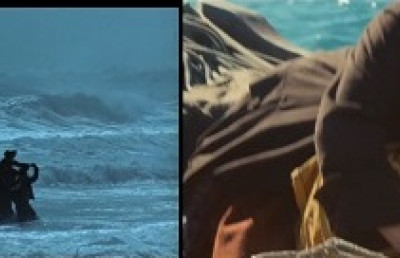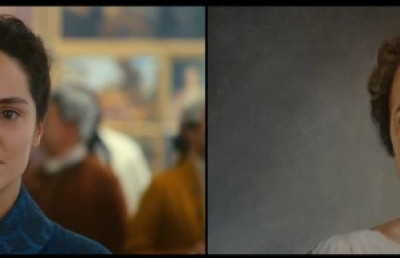Not Recognizing the Boundary: A study of Shohei Imamura’s A Man Vanishes (1967)

“If my films are messy, it is probably because I don’t like too perfect a cinema.”
– Shohei Imamura 1
Watching the great Shohei Imamura’s A Man Vanishes (1967) is not an easy experience, as one is constantly bombarded by questions which, I dare say, are almost impossible to answer. These queries involve the mysterious disappearance of one of the so-called “evaporated people” (a literal translation of Ningen Johatsu, the Japanese title of the movie) and also whether it is possible for a movie to be appraised as either documentary or fiction.
A Man Vanishes believably starts as a documentary with the aim of helping the people most close to the lost man (Tadashi Oshima), especially his fiancée (Yoshie Hayakawa), come to terms with his disappearance. A film crew (including Imamura himself as the director) conducts an extensive investigation in order to find a possible reason as to why Oshima left everything behind to, metaphorically, evaporate. As I was watching it for the first time, I recalled the situation in Woman in the Dunes (Hiroshi Teshigahara, 1964). It seemed to me that – excluding the name of the characters and their professions – A Man Vanishes can be seen as a rough recounting of the narrative of Woman in the Dunes from the point of view of the people related to the lost man and the frustrating process some of them go through in order to wholly accept his disappearance, despite not being aware of the exact reason he might have had for choosing to live a life totally severed from the people he had been socially bound to leading up to his disappearance.
It should be noted that such deliberate disappearances, which according to journalist Léna Mauger is still occurring in Japan 2 , was particularly publicized in the 1960s. The stigma inflicted upon the family of the Vanished (the Johatsu) is mentioned in a few lines of dialogue in A Man Vanishes. Oshima has very humble roots. He comes from a family who live in a village, yet manages to make his way to Tokyo through work, and settles there in a dorm. Nevertheless, it is not easy for Oshima’s family to bear the disgrace of letting their son’s disappearance be known to the other villagers. By collaborating with the film crew and providing information about Oshima, they hope that he might watch the footage on TV and be compelled to contact them. What is noteworthy in this situation is that they are the only family in the village who own a TV set, so the matter would still be kept a secret from their friends and neighbors in their small vicinity. “This film was inspired by cases of sudden disappearance by ordinary people, which at the time was a social phenomenon that regularly caused a sensation in the mass media,” asserts Nada Hisashi as he muses on the experimental characteristics of A Man Vanishes. Considering both the movie’s demonstration of the Oshima family’s approach to his disappearance and the accounts given by Mauger, it would appear that Imamura is satirizing the role of mass media in tackling the sensitive issue of the Johatsu. This becomes even more obvious in the sequence in which the film crew, along with Oshima’s fiancée Yoshie, hold a press conference about their investigation. Less than two minutes after this sequence, as the crew goes to investigate Yoshie and her sister’s previous apartment, they discuss whether what they are filming is fiction or non-fiction. Such an unexpected discussion among the people involved in the investigation places all the footage that we have watched before this moment into another perspective and disentangles us from it. In this way, Imamura introduces the estrangement effect foregrounded by Brecht. Used for social commentary in the eyes of Brecht, the effect is achieved by making the viewer consciously analyze what he/she is watching instead of being passive 3 . By loosening the grip of documentary, Imamura forces us to examine the film as fiction or non-fiction. Another consequence of such alienation from the flow of the movie is that we come to see the role mass media play in covering news and incidents in a new light (an example of which is the case of the Johatsu). This might lead to questions about the veracity of their coverage or, to be more precise, the extent to which they remain loyal to the truth of a situation.
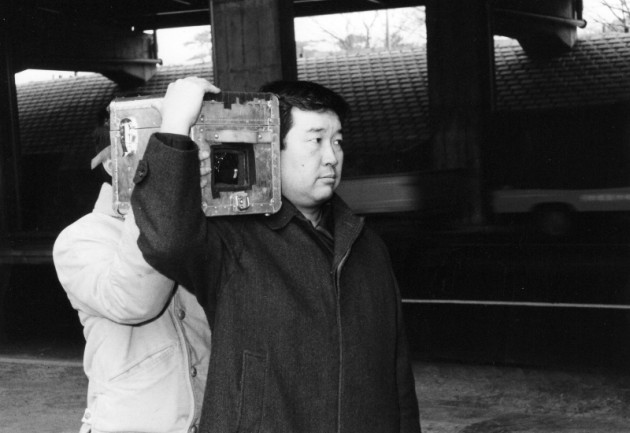
Imamura with hidden camera
Near the end of the movie, Imamura repeats several times that “This is fiction.” Still, throughout the film, he manages to keep it messy by maintaining the air of documentary. This is achieved by exercising rapid movements of the camera from character to character, protecting the anonymity of some interviewees by occluding their eyes with black bars, filming grainy shots, and showing seemingly credible documents such as Oshima’s salary receipts, banknotes, and cab receipts.
Most important of all, the disjointed quality of the information recorded during the investigation is retained throughout the movie. Imamura’s surprising digressions into the life of people related to Oshima is key in corroborating the documentary style of the film. This is a very intriguing aspect of A Man Vanishes_— the way Imamura provides bits of information about the lives of the people somehow related to the lost person. It is also an indication of his continuous fascination with anthropology —as evident from his previous films, the most telling of which is _The Pornographers (1966), which he typically subtitled “An Introduction to Anthropology” 4 The sequences showing the work of the medium and her conversations with Oshima’s family members and Yoshie (his fiancée), though seemingly related to his disappearance, are mostly occasions of anthropological study by displaying the traditional acts and religious beliefs of this section of Japanese society.
Oshima’s disappearance is the backdrop against which Imamura is able to brush over anthropological issues such as the importance of the honor of one’s family name and the burden of being the first son of the family among the Japanese. He is also able to make the observation that the family system in Japan is what sustains not-so-big companies. Though all these details seem irrelevant to the main subject matter, Imamura appears to intentionally accumulate these fragmented pieces of verbal/visual data about the group of people he encounters as a consequence of searching for the reason of Oshima’s disappearance.
The extensive use of photographs throughout the movie, though seemingly adding depth to its documentary façade, accentuate the tenuous boundary between fiction and non-fiction. The avid viewer would not have enough clues to decide on the credibility of the photos. As much as they seem convincing, they might as well be staged.
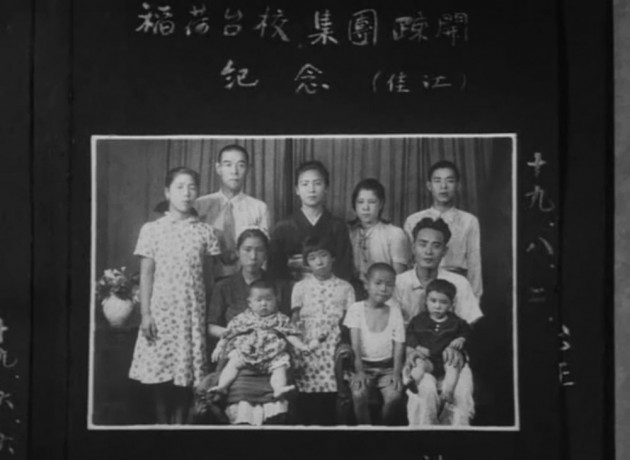
A photo from the family album of Yoshie and her sister
Imamura’s masterful handling of sound also helps in keeping the movie on the boundary of fiction and documentary. The sound quality is low in many scenes. This supports the idea of the film being made spontaneously on the spot. There are also many occasions in A Man Vanishes in which the discrepancy between what is heard and what is seen not only creates the air of documentary but also produces the Brechtian estrangement effect. This difference between auditory and visual stimuli keeps the viewer from giving in to passivity as a consequence of becoming too involved in what is happening.
An example of the artful combination of sound and visuals is the two occasions 5 when, with a very sharp noise 6 , the film suddenly cuts to seemingly irrelevant shots of a white-clad figure sitting in the only illuminated part of a dark room.
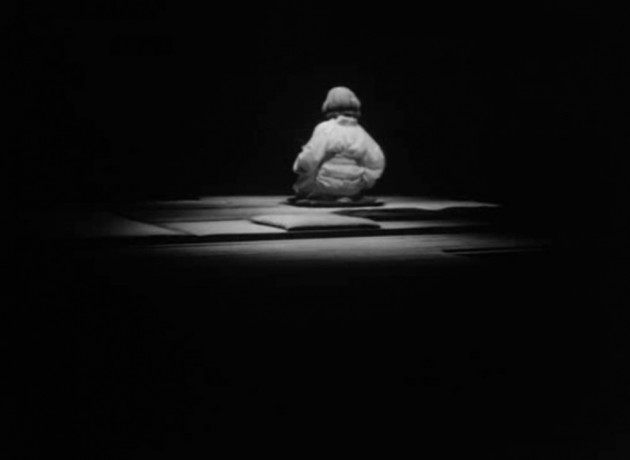
The mysterious white-called figure
We hear the same sharp noise for the third time over a close-up of the back of Yoshie’s neck, right after her listening to the recordings of the interviews with different people during the investigation and right before her musings to herself or to the investigator as she moves about in the snow. Hearing the noise that we have already associated with that particularly obscure shot arouses an eerie feeling, anticipating the image which is deliberately not displayed. The shot of the white-clad figure combined with the sharp noise is shown once more before we finally learn who the figure is and what she is doing: a medium trying to get in touch with Oshima’s spirit to inform Yoshie of his fate (after almost two thirds of the movie has passed). This encryption of information through visuals and sound triggers the viewer’s desire to decipher both the enigma of Oshima’s disappearance and the inner workings of Yoshie’s thoughts and emotions.
Throughout the roughly 5-minute sequence where Yoshie (Oshima’s fiancée) and Kimiko (the woman, who according to most interviewees, Oshima loved ) meet and talk, Imamura selects different modes for visually displaying the two women, in a calculated attempt to convey their emotional state (regarding Oshima) to the viewer. All shots of Kimiko are ordinary moving images whereas all shots of Yoshie are freeze frames, taken while she was talking to Kimiko. As they talk we come to the conclusion that Kimiko has completely moved on and does not harbor any romantic emotion towards Oshima, while Yoshie still wants to know the reason for Oshima’s sudden disappearance. Her desire to finding out the reason and her longing after Oshima go hand in hand to connote that she is still involved in a wrenching struggle to release herself of her past in order to move forward. Her mental grappling with the past is both conveyed by the content of her talk with Kimiko and by only showing her in freeze frames during the mentioned sequence, which essentially implies that she hasn’t been able to move on. Imamura’s adoption of freezes for displaying Yoshie in this sequence is an experimentation in relating emotional attachment and emotional detachment to freeze frames and to moving images respectively.
In the introductory scenes before the title sequence, Yoshie talks about memory, love, and not being able to forget Oshima since his disappearance. “I can’t forget about him. That means I still love him, I think,” expounds Yoshie, in reply to the investigator’s inquiry of whether she still loves Oshima. In the course of the movie, we witness how she moves on the edge of her emotions toward present and absent characters (her sister Sayo, Oshima, the investigator) as she tries to get hold of the reason for Oshima’s disappearance. By employing the methods of documentary-making, staging scenes as if they are happening naturally, yet insisting that what is made is fiction (especially near the end of the film), Imamura succeeds in demonstrating the fleeting nature of emotions, their acute dependency upon memory, and the very human tendency to rationalize them.
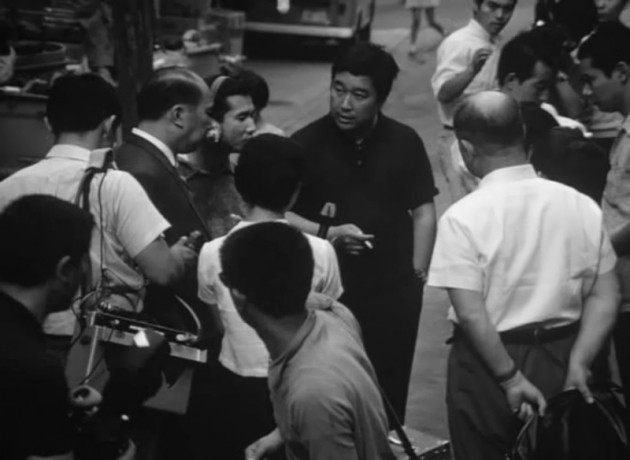
Among this hodgepodge of information collected as the film progresses, Imamura is not oblivious to the struggle of Japanese women as they try their chances at becoming financially independent. Sayo’s financial dependency on a boyfriend is judged harshly, whereas she seems to have had few choices to secure an income. Her shot at becoming a geisha is looked upon lowly by other people, especially her own sister, Yoshie, who considers Sayo’s choice of profession a disgrace for the family. All this information is given through other people knowing the sisters, and just a little interrogation of Sayo. Imamura goes into such extent in exploring the lives of the two sisters and their relationship that finally something resembling a love triangle forms among Yoshie, Oshima, and Sayo. This love triangle, like many other notions in the film, has an ever-elusive quality. It is tackled in such a way that its existence and realness before Oshima’s disappearance remains enigmatic at the end of the film.
A Man Vanishes boldly resists to give the viewer the chance to concoct a straightforward narrative out of what is represented. The fragmented nature of the movie and the bits of data that do not quite attach to form a whole hold forth the most important questions of the movie: what is fiction? What is non-fiction? And is it even possible to draw a clear boundary between the two? The film’s answer to the last question is definitely negative. Imamura succeeds in shattering the cinematic notion of making a documentary loyal to reality.
Unfolding on the fragile boundary between fiction and non-fiction, A Man Vanishes succeeds in raising questions rather than providing answers, both about the situation of the lost man and about the nature of film-making, or more accurately, the nature of telling a story through moving images and whether that story is unfolding naturally or is staged.
Works sited
Mauger, Léna; Remael, Stéphane. “The Vanished: The “Evaporated People” of Japan in Stories and Photographs.” Translated into English by Brian Phalen, Skyhorse Publishing, 2016.
Hisashi, Nada. “Self-Documentary: Its Origins and Present State.” As appeared on the website of Yamagata International Documentary Film Festival (http://www.yidff.jp/docbox/26/box26-2-e.html), accessed on Dec. 27, 2016.
Brecht, Bertolt. “Brecht on Theatre: The Development of an Aesthetic.” Edited and translated by John Willet, Eyre Methuen, 1974 (third printing).
Richie, Donald. “A Hundred Years of Japanese Film.” Kodansha International, 2005.
All photos are film stills from A Man Vanishes (Shohei Imamura, 1967)
Notes
- Quoted in Donald Richie, “A Hundred Years of Japanese Film” (Kodansha International, 2005), 189 ↩
- Léna Mauger and Stéphane Remael, “The Vanished: The “Evaporated People” of Japan in Stories and Photographs.” Translated into English by Brian Phalen, Skyhorse Publishing, 2016, 8. In this book, Mauger collaborates with photographer Stéphane Remael to give poignant accounts of some of these disappearances in our time. ↩
- Bertolt Brecht, “Brecht on Theatre: The Development of an Aesthetic.” Edited and translated by John Willet, Eyre Methuen, 1974 (third printing), 91. Though Brecht elaborates on this concept with regard to theater, it has the capacity to be applied to the experience of watching a movie. ↩
- Quoted from J. Hoberman’s essay on the same movie (https://www.criterion.com/current/posts/294-the-pornographers). Inquiring about the past of Oshima’s father and the fact that his father is an illegitimate son has little to do with Oshima’s disappearance. A very heart-warming example of gathering this seemingly unrelated material for the movie is when Imamura queries about the TV which Oshima’s father has won in a lottery many years ago. This is a piece of information which is absolutely unrelated to Oshima’s disappearance. Imamura is still interested in it (whether it is fiction or non-fiction). [[Most probably in order to lead the avid viewer to a better understanding of the stigma inflicted upon the family because of their son’s disappearance, as I elaborated on earlier. ↩
- One around 37:14, the other around 54:24. ↩
- Thanks to the brilliant music score composed by Mayuzumi Toshirô ↩





-small_400_258_90_s_c1.jpg)
_2_400_258_90_s_c1.jpg)
